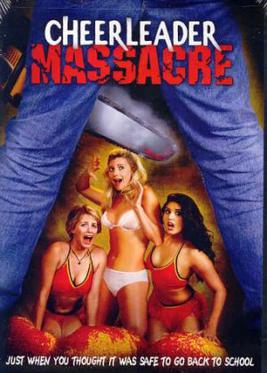
Masculinity is a set of attributes, behaviors, and roles associated with men and boys. Masculinity can be theoretically understood as socially constructed, and there is also evidence that some behaviors considered masculine are influenced by both cultural factors and biological factors. To what extent masculinity is biologically or socially influenced is subject to debate. It is distinct from the definition of the biological male sex, as anyone can exhibit masculine traits. Standards of masculinity vary across different cultures and historical periods.

Amy Heckerling is an American writer, producer, and director. Heckerling started out her career after graduating from New York University. Her career started from independent films to directing major studio films.

Mirror, Mirror is a 1990 American supernatural horror film directed by Marina Sargenti, based on a screenplay by Annette Cascone and Gina Cascone. It stars Karen Black, Rainbow Harvest, Yvonne De Carlo and William Sanderson. The film follows a teenage outcast who finds herself drawn to an antique mirror left in the house she and her mother have moved into. A soundtrack was released in 1990 through Orphan Records. Three sequels followed in 1994, 1995 and 2000.

Night of the Demons 2 is a 1994 American horror film directed by Brian Trenchard-Smith and starring Amelia Kinkade, Cristi Harris, Rick Peters, Jennifer Rhodes and Christine Taylor. It is the sequel to Night of the Demons and was released on home video in 1994 by Republic Pictures Home Video. Lionsgate released it on DVD in 2007; Olive Films released a widescreen DVD and a first time Blu-ray release on February 19, 2013. The film was followed by the 1997 sequel Night of the Demons 3.

Richard Dyer is an English academic who held a professorship in the Department of Film Studies at King's College London. Specialising in cinema, queer theory, and the relationship between entertainment and representations of race, sexuality, and gender, he was previously a faculty member of the Film Studies Department at the University of Warwick for many years and has held a number of visiting professorships in the United Kingdom, the United States, Italy, Sweden, Denmark, and Germany.

Beyond the Stars is a 1989 American science-fiction drama film written and directed by David Saperstein and starred Martin Sheen, Christian Slater, Sharon Stone, Olivia d'Abo, and F. Murray Abraham. The film was originally titled Personal Choice. It was never released in theaters.
The Virgin Queen of St. Francis High is a 1987 Canadian teen comedy film directed by Francesco Lucente and starring Joseph R. Straface, Stacy Christensen, and J. T. Wotton. The plot concerns a teenage Casanova who bets his high school rival and his friends, that he can obtain the school beauty queen.

Johnny Get Your Hair Cut is a 1927 silent American comedy film directed by B. Reeves Eason starring Jackie Coogan and featuring Harry Carey. A print is preserved by Metro-Goldwyn-Mayer, but is not publicly available.

Cheerleader Massacre is a 2003 American B-movie slasher film directed by Jim Wynorski and written by Lenny Juliano. It is the seventh installment in the Massacre franchise and was originally meant to be a direct sequel to The Slumber Party Massacre (1982).

Murray Pomerance is an independent Canadian film scholar and author living in Toronto, Ontario, Canada, and adjunct professor in the School of Media and Communication at RMIT University, Melbourne.
Misogyny in rap music is defined as lyrics, videos, or other components of rap music that encourage, glorify, justify, or legitimize the objectification, exploitation, or victimization of women. It is an ideology that depicts women as objects for men to own, use, and abuse. It reduces women to expendable beings. It might include everything from innuendos to stereotypical characterizations and defamations.
Catherine Driscoll is an Australian professor of Gender and Cultural Studies at the University of Sydney. She grew up in Wauchope, New South Wales and was educated at Wauchope High School, the University of Newcastle (Australia), and the University of Melbourne. She has worked at the University of Melbourne, the University of Adelaide, and joined the School of Philosophical and Historical Inquiry at the University of Sydney in 2003. She has held visiting fellow positions at Duke University, Columbia University, Cardiff University, and the Australian National University.

The representation of gender in horror films, particularly depictions of women, has been the subject of critical commentary.
Charles Reid Acland is a Canadian professor in the Communications Studies Department at Concordia University, Montreal. He specializes in cultural theory and his research interests include film studies, media studies and popular culture. He is the Editor of the Canadian Journal of Film Studies and co-editor of Useful Cinema, Residual Media (2007), and Harold Innis in the New Century (1999).
Gender plays a role in mass media and is represented within media platforms. These platforms are not limited to film, radio, television, advertisement, social media, and video games. Initiatives and resources exist to promote gender equality and reinforce women's empowerment in the media industry and representations. For example, UNESCO, in cooperation with the International Federation of Journalists, elaborated the Gender-sensitive Indicators for Media contributing to gender equality and women's empowerment in all forms of media.
A bromantic comedy is a comedy film genre that takes the formula of the typical "romantic comedy" but focuses on close male friendships.
The Massacre films are three interconnected series of slasher films executive-produced by Roger Corman: the Slumber Party Massacre series (1982–1990), the Sorority House Massacre series (1986–1990) and the Cheerleader Massacre series (2003–2011), distributed by New World Pictures and New Concorde. The series also features the standalone film Sharkansas Women's Prison Massacre (2015), and the reboot film Slumber Party Massacre (2021).
Barry Keith Grant is a Canadian-American critic, educator, author and editor who best known for his work on science fiction film and literature, horror films, musicals and popular music and other genres of popular cinema.
Maria San Filippo is an American author and educator. Her first book, The B Word, won the Lambda Literary Award for Bisexual Nonfiction; she also won the 2023 award for Appropriate Behavior.










